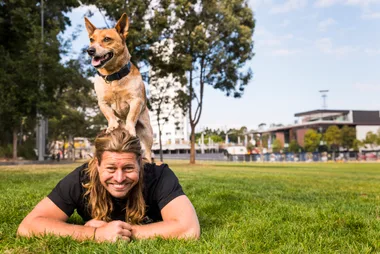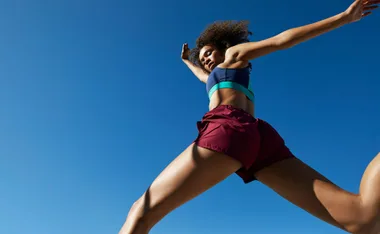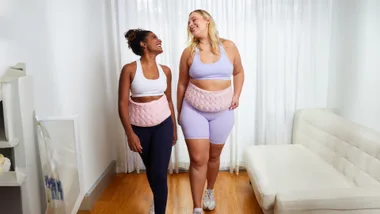Exclusive extract from The Stone Angel (Macmillan) by Katherine Scloles.
Stella’s hand looked large and pale in the undersea light. Strands of hair drifted in front of her mask. She held onto a rock as a swell came through, swirling the weeds. When the sea became still again she pulled her knife from the sheath strapped to her leg. She reached towards one of the pink and brown abalone shells that lined a rocky ledge. Digging the tip of the wide blade under the shell, she twisted it firmly, flicking the shellfish away from the rock and catching it with her hand. She worked quickly. Once an abalone got a chance to clamp on, she knew it was almost impossible to prise it free.
She had brought no diving bag — just her mask and snorkel — so she surfaced with each shellfish and handed it to Zeph. He stood on a rock with a bucket, reaching out to her as she appeared with her catch in her hand. She felt a surge of pride each time. It took skill to pick them off without dropping them, and she sensed that he knew it. When she had collected six large abalone she swam in to the beach. She sat there enjoying the heat of the midday sun. She felt her skin warming, drying — her bikini top becoming two cold wet triangles over her breasts. Zeph walked round towards her, the bucket swinging in his hand. He wore just a cloth wrapped around his waist. Only two days ago, Stella remembered, it had been strange to see a man in a skirt, yet now it looked normal. Things could change so quickly.
‘What do we do with them now?’ Zeph asked. He sat beside Stella, looking down into the bucket. The abalone squirmed out from their shells, searching for the familiar touch of the rock, and finding only smooth plastic or the shells and bodies of their companions.
‘You don’t want to know,’ grinned Stella. They had to be cut from their shells, their guts ripped away, and then all the black slime scraped off. Only then could they be sliced into thin strips, ready for frying.
Zeph learned quickly how to clean and prepare the abalone. Soon he was working alongside Stella so efficiently that he might have been doing it for years. Stella watched the way his hands gripped that shell and held the knife. She pushed aside an image of Jamie’s hands carrying out the same tasks in exactly the same way. She felt disloyal, as though the cleaning and slicing were an intimate ritual that she had no right to be sharing.
Zeph held one of the abalone in his hand, observing the way the shellfish twisted in its shell — glistening wet, changing shape. Watching him, Stella felt a warm blush on her cheeks. The boys often laughed at the abalone, saying they looked like girls’ fancies. ‘How would they know?’ Laura liked to say. ‘They’ve never had a good look.’ It was true, the boys got to feel rather than see their girlfriend’s bodies — reaching down inside their jeans then pushing up into the softness, If anyone went as far as undressing they always did it in the dark.
Stella glanced at Zeph. She imagined him standing naked in the bright light of day — not feeling the need to hide anything. And not expecting a girl to hide, either…
‘They cook best over a fire,’ Stella said, wanting to fill the air with words. ‘Just for a few minutes, very hot. But I’m not sure where to light one. If anyone sees the smoke they’ll come.’ In fact, she knew the whole volunteer fire brigade might come, headed up by Jamie’s uncle Bill.
‘I’ve got a little spirit stove,’ Zeph said. ‘For emergencies. I’ll bring it across with a pan. What else do we need?’
Stella gestured towards her shoulder bag. ‘I’ve got butter and lemon, salt and pepper. That’s everything.’
Zeph nodded and turned away. As if spurred by hunger, he ran towards the yacht. The way he tied his sarong allowed his legs to move easily. Stella watched the muscles flexing in his calves and across his back. He had the body of a man — even though his hair, streaming back behind him, and the careless way he moved, made him look like a boy.
They cooked in the shade, fronds of she-oak dangling over their heads. The slivers of white flesh curled and spat in the hot butter. The sea air was laced with the tang of curt lemon and the smell of burning methylated spirits.
‘How long are you staying?’ Stella had to ask. She wanted to know when it was going to time to say goodbye.
‘I should leave soon,’ Zeph replied. ‘I’ve fixed the self-steering gear now. I made a plan to meet Bakti in New Zealand. I have to be there.’
‘How long will it take for you to sail that far?’ Stella asked. She tried to keep her tone light.
‘I’ll have to get going tomorrow. Next day at the latest.’
The two were silent. Butter hissed in the pan. Then Zeph spoke again.
‘Why don’t you come with me? Bakti wouldn’t mind. I could bring you back — a few weeks from now. In time for school.’
Stella laughed.
‘No, I’m serious.’
She shook her head. Did he really imagine that she could just leave with him on his yacht, she wondered. ‘I’ve got — things to do — you know, I’ve got to pack up…’ She looked at him. He probably thinks I am older, she told herself. People often did, because she was tall. ‘I’m only sixteen.’
‘Sixteen…’ Zeph repeated. ‘I was living on my own by then. Bakti moved to another ashram. I stayed in Goa.’ He looked over to the yacht. ‘That’s when I met Wolfgang. He was looking for someone to take care of his children. His wife, Lotte, had hepatitis — she was really sick. I lived with them. They had six children. Three girls and three boys. The youngest was only a baby. Nina…’
Zeph sifted dry sand through his fingers as he talked. When he mentioned the baby’s name, he paused, his hand hovering in the air. A smile curved his lips briefly — then it was gone.
‘There was some problem back in Germany — one day they all just left. I looked after Tailwind in case they came back. Wolfgang said they would. I hoped they would — I liked living with them. I really missed the kids.’ His voice softened. Stella saw him surrounded by little blond-haired children, a baby in his arms. ‘I waited for them — nearly a year. Living on board. They never came back. So I sailed her away. And here I am…”
‘Don’t go tomorrow.’ The words fell from Stella’s lips unplanned. ‘I want to come back once more.’
‘You’ll have to go,’ Zeph said straightaway. ‘I haven’t written your goodbye note yet.’
Stella smiled at him. She wrapped her arms around her knees, hugging them against her body. One more visit, she told herself. Then it would all be over. She would go back to being the girl she used to be. Jamie’s girl. William’s girl.
Just one more visit.
It was nothing.
But at the same time — she knew — it was everything. A gift that would stay with her forever, whispering in her heart like the hush of a quiet sea.
Newsletter conversion description. Get the latest in your inbox.











































.png?resize=380%2C285)
.jpg?resize=380%2C285)



.png?resize=380%2C285)




